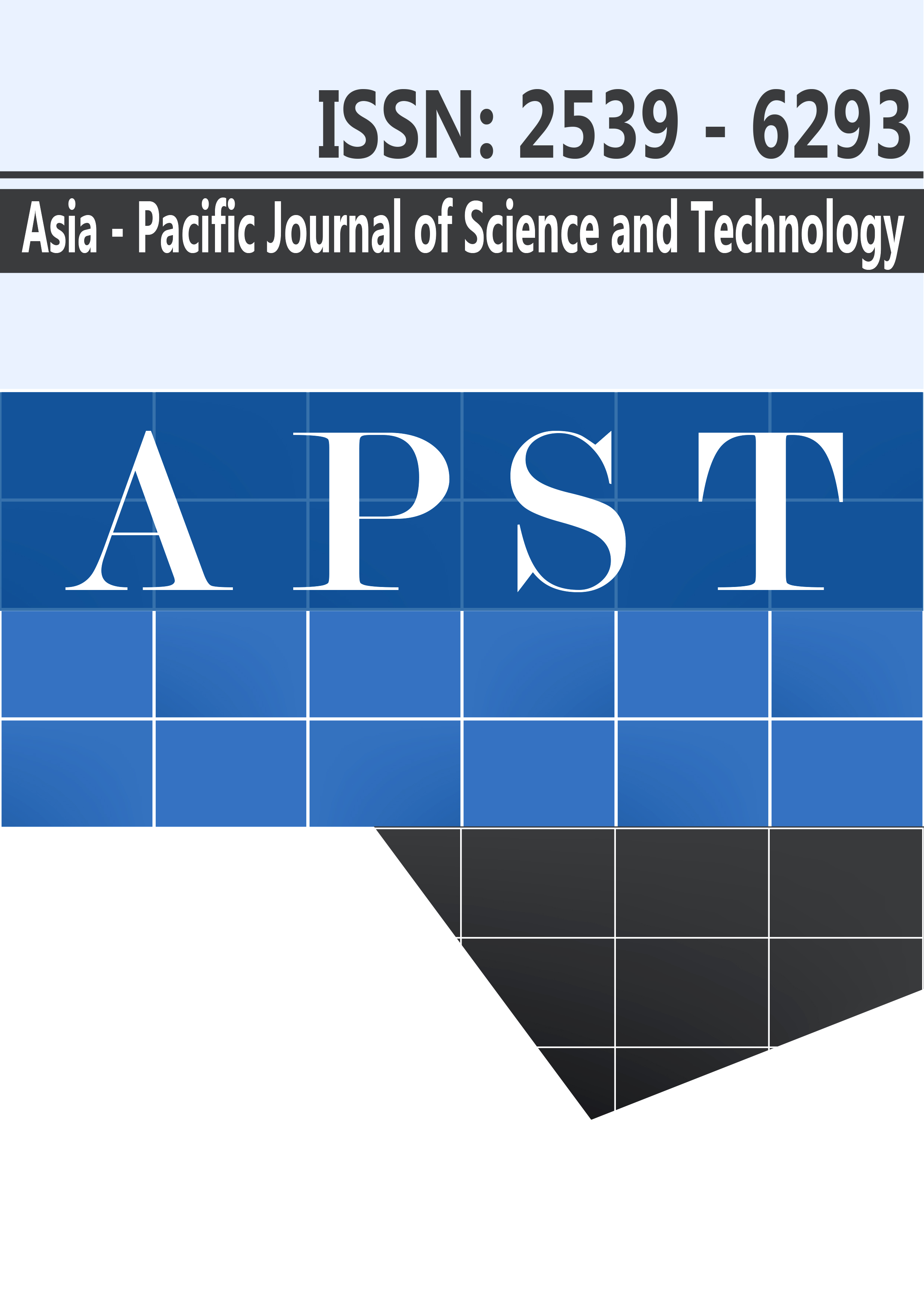Screening of N2-fixing and IAA Producing Bacteria and their Potential Use as Biofertilizer for Rice
Main Article Content
Abstract
The rice-based farming system is widespread throughout Thailand. Approximately 98% of the rice is farmed in a paddy field. The long time inefficient use of chemical fertilizers has dramatically degraded the soil quality and polluted the environment. Rhizosphere-associated nitrogen-fixing bacteria are considered one of the possible alternatives to synthetic nitrogen fertilizer for improving rice growth and yield. The objectives of this study were to isolate bacteria from rice rhizosphere and evaluate their potential in N2-fixation and indole 3-acetic acid (IAA) production. A total number of 31 isolates of Azotobacter and 24 isolates of Beijerinckia were obtained from the rice rhizosphere soils. The results showed that Beijerinckia BCk1 performed maximum nitrogenase activity (68.4 nmole 24hr-1 tube-1) and Azotobacter AtMh6 showed the highest IAA production (28.0 mg IAA L-1). Nitrogen uptake and rice seedlings growth promotion by six selected isolates; AtMh6, AtCk1, AtMh1, BCk1, BSt3 and BSt12 with high potential in N2-fixation (64.6, 60.2, 56.6, 68.4, 57.0 and 50.4 nmole 24hr-1 tube-1, respectively), were investigated. IAA production of the six isolates was 28.0, 7.2, 3.3, 17.3, 1.4 and 6.6 mg IAA L-1, respectively. The application of all the selected isolates provides higher nitrogen uptake and seedlings growth than the uninoculated control. Among Azotobacter, isolate AtCk1 gave the best seedling growth and 91.7% increase in N uptake over the control. The Beijerinckia isolate BCk1 exhibited highest nitrogenase activity and also provide the highest nitrogen uptake in rice seedlings (150% over the control). Our results suggested that isolate AtCk1 and BCk1 have a high potential to develop as biofertilizer for rice.
Article Details
References
Department of Agricultural Extension. Farmer Database. Information Technology and Communication Center. Department of Agricultural Extension. Bangkok; 2016. 31 p.
Office of Agricultural Economics. 2015. Agricultural statics of Thailand 2015. Office of Agricultural Economics. Bangkok; 2015. 240 p.
Bashir MT, Ali S, Ghauri M, ADRIS A, Harun R. Impact of excessive nitrogen fertilizers on the environment and associated mitigation strategies. Asian Jr. of Microbiol. Biotech. Env. Sc. 2013; 15(2):213-221.
Fageria NK, Baligar VC. Enhancing nitrogen use efficiency in crop plants. Adv Agron, 2005; 88: 97-185.
Baca BE, and Elmerich C. 2007. Microbial production of plant hormones. In: Elmerich C, Newton W, editors. Associative and endophytic nitrogen-fixing bacteria and cyanobacterial associations. Dordrecht: Springer; 2007. p. 113-143.
Spaepen S, Vanderleyden J, Remans R. 2007. Indole-3-acetic acid in microbial and microorganism–plant signaling. FEMS Microbiology Reviews, 2007; 31:425–448.
Carvalho TLG, Balsemão-Pires E, Saraiva RM, Ferreira PCG, Hemerly AS. Nitrogen signalling in plant interactions with associative and endophytic diazotrophic bacteria. Journal of Experimental Botany, 2014; 65(19): 5631–5642, https://doi.org/10.1093/jxb/eru319
Döbereiner J and Pedrosa FO. Nitrogen-fixing bacteria in non-leguminous crop plants. Springer, Madison; 1987. 155pp.
Khammas, KM, Ageron E, Grimont PAD, Kaiser P. Azospirillum irakense sp. nov., a nitrogen-fixing bacterium associated with rice roots and rhizosphere soil. Res Microbiol. 1989; 140: 679–693.
Baldani, VLD, Baldani JI, Döbereiner J. 1983. Effects of Azospirillum inoculation on root infection and nitrogen incorporation in wheat. Canadian Journal of Microbiology. 1983; 29: 869-881.
Perin L, Martinez-Aguilar L, Paredes-Valdez G, Baldani JI, Estrada-de-Los Santos P, Reis VM, Caballero-Mellado J. Burkholderia silvatlantica sp. nov., a diazotrophic bacterium associated with sugar cane and maize. Int. J. Syst. Evol. Microbiol. 2006; 56:1931-1937.
Koomnok C, Teaumroong N, Rerkasem B, and Lumyong S. Diazotroph endophytic bacteria in cultivated and wild rice in Thailand. Science Asia, 2007; 33: 429-435.
Deb RB, Deb B, Sharma GD. Dinitrogen nutrition and rice cultivation through biofertilizer technoiogy. Assam University Journal of Science & Technology: Biological Sciences, 2009; 4(1): 20-28.
Roger PA, Ladha JK. Biological N2 fixation in wetland rice fields: Estimation and contribution to nitrogen balance. Plant Soil, 1992; 141: 41–55.
Atlas RM. Handbook of Microbiological Media. Parks LC, editor. Boca Raton, FL: CRC Press; 1993.
Weaver RW, Denso KA. Dinitrogen fixation. In: Methods of analysis part 2 microbiological and biochemical properties. Soil Science society of America, Inc; 1994, p. 1019 – 1043.
Hardy RWF, Holsten RD, Jackson EK, Burns RC. The acetylene–ethylene assay for N2 fixation: Laboratory and field evaluation Pl. Physiol. 1968; 43:1185-1207.
Somasegaran P, Hoben HJ. Handbook for Rhizobia. Methods in Legume–Rhizobium Technology. Heidelberg, NY: Springer; 1994.
Gordon SA, Weber RP. The colorimetric estimation of indole acetic acid. Plant Physiology. 1951; 26:192-195. doi: https://doi.org/10.1104/pp.26.1.192
Nelson DW, Sommers LE. Total nitrogen analysis of soil and plant tissue. J.Assoc. Off. Anal. Chem. 1980; 63:770-778.
Purushothaman D, Balasundaram CS, Gunasekaran S. Nitrogen fixation in the rhizosphere of rice. Proc. Indian natn. Sci. Acad. 1980; 47(2): 242-247.
Kanimozhi K, Panneerselvam A. Studies on isolation and nitrogen fixation ability of Azospirillum spp. isolated from Thanjavur district. Der Chemica Sinica, 2010; 1(3): 138-145.
Poonguzhali S, Madhaiyan M, Sa TM. Isolation and identification of phosphate solubilizing bacteria from Chinese cabbage and theire ffect on growth and phosphorus utilization of plants. J. Microbiol. Biotechnol. 2008; 18:773–777.
Majeed A, Abbasi MK, Hameed S, Imran A, Rahim N. 2015 Isolation and characterization of plant growth-promoting rhizobacteria from wheat rhizosphere and their effect on plant growth promotion, ORIGINAL RESEARCH, 2015; 6: 1-10. doi:10.3389/fmicb.2015.00198
Ahmad F, Ahmad I, Khan MS. Indole acetic acid production by indigenous isolates of Azotobacter and Fluorescent Pseudomonas in the presence and absence of tryptophan. Turk. J. Biol. 2005; 29: 29-34.
Mwajita MR, Murage H, Tani A, Kahangi EM. Evaluation of rhizosphere, rhizoplane and phyllosphere bacteria and fungi isolated from rice in Kenya for plant growth promoters. SpringerPlus, 2013; 2:606 doi: 10.1186/2193-1801-2-606

